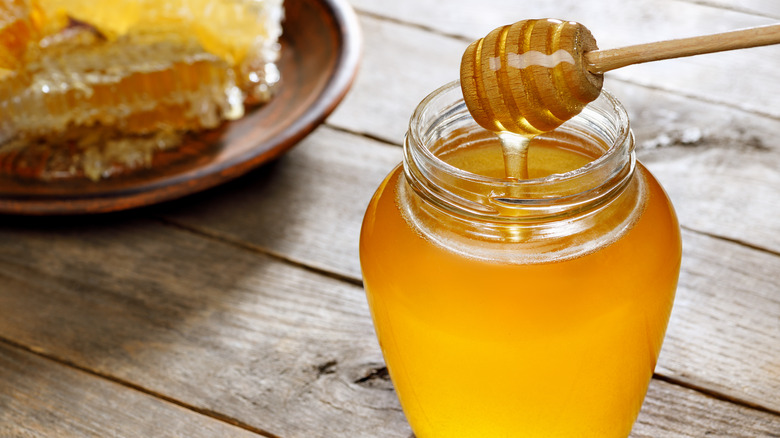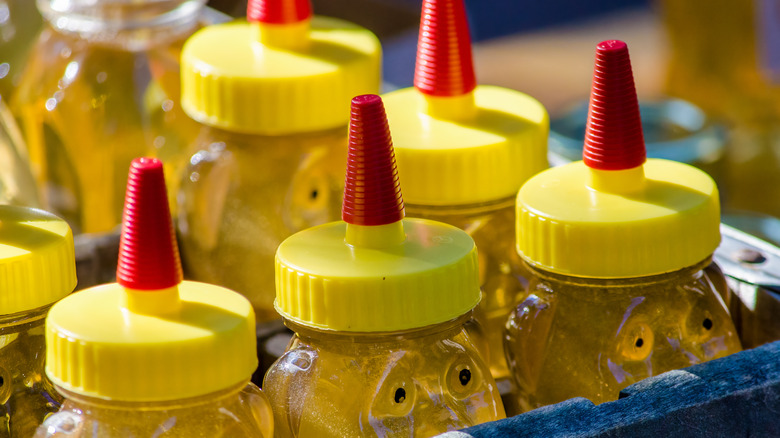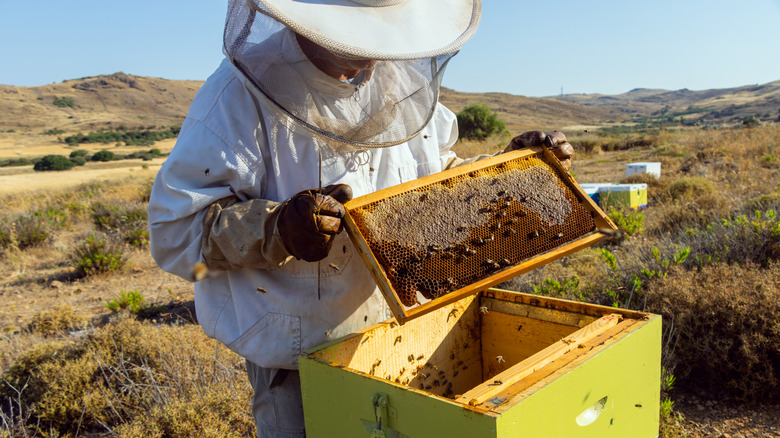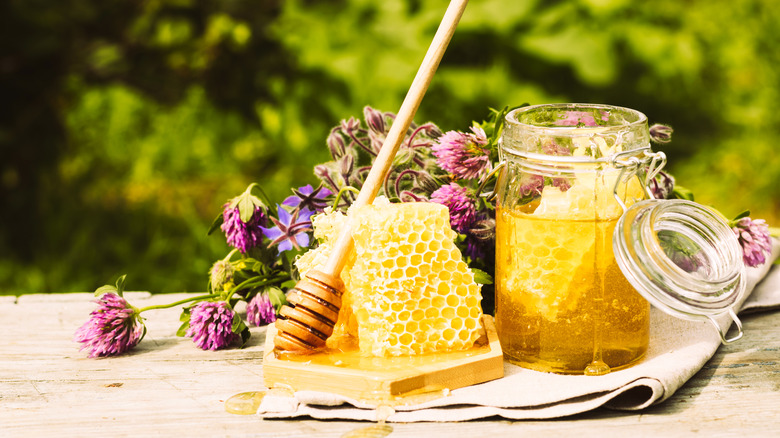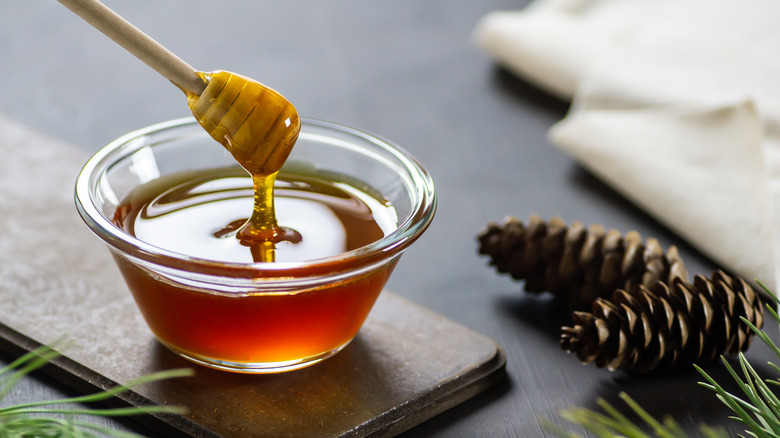American Vs Greek Honey: What's The Difference?
Did you know there are at least 26 different types of honey out there? Some are easier to spot, like purple, orange blossom, and manuka, while others you'd have to taste to tell the difference. Considering the world's oldest jar of honey is from 3500 BCE, the nectar of the gods has had plenty of time to make its way around the world. And it's done just that for thousands of years, as there are records of the sweet substance from ancient times in Egypt, China, Rome, and Greece.
In today's world, Greek honey has grown up to be a pretty different condiment than the honey we're squeezing out of plastic bear-shaped bottles in the U.S. This substance has been widely used in the U.S. since European colonists introduced it in 1622, yet it's been cultivated in Greece for so much longer. Some may say that honey from this Mediterranean country is the world's best, and while that's, of course, subjective, there are a few factors that make the claim a strong possibility. So what's the difference between these two types of sweetener? Let's find out.
What is American honey?
The U.S. is often referred to as a melting pot of different cultures, and it's unsurprisingly home to a wide variety of honey types. Clover honey is the one that you likely think of when you imagine the condiment, which makes sense since it's the most common type cultivated here. You can also find orange blossom, acacia, alfalfa, buckwheat, raspberry, and blueberry varieties harvested in the U.S., along with wildflower honey, which comes from American wildflowers. Plenty of our supply inevitably derives from Florida and California, but you may be surprised to learn that North Dakota is the state that produces the most honey.
Honey bees are not native to the geographical region that comprises the Americas, which is why Indigenous Peoples didn't know about honey until European colonists brought the bees over. While they quickly swarmed across the eastern United States in the 17th century, honey bees had to be transported on ships to California in the middle of the 19th century. Eventually, caring for these insects grew to be a job for some early settlers, who used the beeswax to make candles and shoe wax. Today, the pollination from honey bees contributes $15 billion in added crop value in the U.S. (via U.S. Food & Drug Administration).
What is Greek honey?
Honey has long been a staple in Greek cuisine, as it's been around in the area for thousands of years. In fact, the substance was the only sweetener that people in the region used for ages. Aside from its culinary purposes, honey was also deployed medicinally and as an energy booster for athletes in the ancient Olympics. Honey was even a part of ancient Greek mythology, as the demigod Aristaeus was thought to be the first-ever beekeeper who invented the original beekeeping suit. According to the lore, he passed on his discoveries to humans. Back in the day, it was said that Greek gods lived off of the stuff, along with ambrosia (or honey wine).
Whether Aristaeus ever existed or not, we can narrow down the source of modern day Greek honey to a few key places. Some of the most commonly seen types come from pine, fir, and oak trees, although thyme honey is also a classic variety associated with the country. Of these, pine is the most popular, accounting for 65% of Greece's supply, while chestnut is one of the rarer versions (via Yoleni's).
American table honey is light and mild
Considering the plethora of honey varieties cultivated in the U.S., it would be inaccurate to say that American honey can be classified under a single descriptor — but, in general, the bottles we get here are a little thinner and less potent than what you'll find in Greece. Part of this may have to do with the fact that honey bees aren't native to the U.S. The specific flavors, however, come down to what type of plants the bees are collecting nectar from. Two of the most common varieties here, clover and alfalfa honey, are naturally light in color, which means you'll get a milder flavor.
There are also a few key differences in the beekeeping laws in the U.S. and Greece. The U.S. doesn't have set regulations around organic honey, so brands can use this label loosely. The U.S. also doesn't have restrictions about what can be denoted as mono-flower honey. So, technically, a jar can be called a certain type of honey while it has other kinds mixed in. And while climate change is impactful all around the globe, honey production in the U.S. has seen a particular decline in recent years. Although, it finally started rising in 2023, which may be attributed to rainier weather and the subsequent flower blossoms.
Greek honey is rich and potent
There's a reason ancient Greek gods and humans loved this stuff (besides the fact that it was their main sweetening substance back in the day). Greek honey is said to be tastier than ours here in the U.S. At the London Honey Awards, Greece was the second-most honored country for honey production, raking in 29 awards in 2023. The difference in quality largely lies in its richer flavor and thicker consistency. If you take a whiff of a container, you'll also find that it has a stronger, more pleasant scent than the American varieties. Greek jars often have deeper flavors as well — for instance, thyme honey has woody, slightly tart notes, while pine honey has hints of caramel and spice.
The warm, lush climate of the Mediterranean is a huge part of what goes into Greek honey that makes it some of the best in the world. Some scientists have claimed that the country has the widest variety of vegetation in the Mediterranean basin, which essentially makes it Disneyland for honey bees. Greece also boasts a plethora of different landscapes, including forests, mountains, and islands. Plus, these insects are rooted into Greek history and culture. They're a highly valued part of the ecosystem, and local beekeepers take pride in protecting their hives and producing the highest-quality products.
